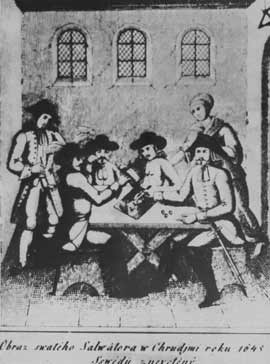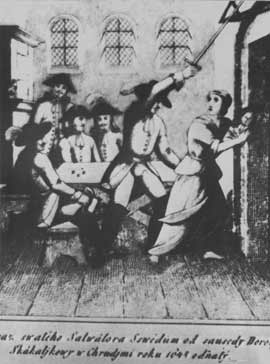The tale about Miraculous painting
A painting of the Savior, held by tradition to have miraculous powers, has been kept in the Chrudim church of the Assumption of the Virgin Mary. Religious processions to the painting were made as early as the 17th century.
It has been proposed that the painting was looted by the retreating Swedish army from the Rudolph II collection when the Swedes, on 26.7.1648 occupied the Prague castle as the Thirty Year War drew to a close.
Subsequently the painting was lost in transit and recovered by a person who sold it to Ferdinand Vilem Slavata. The latter was stricken with fatal illness and died in the home of Jan Pfeiffer (the current city office building). The painting thus remained in Chrudim since August, 1648.
When it became know that the Swedes were about to push into Moravia, Pfeiffer reportedly took himself and family out of town, leaving the household in the care of Dorota Skalikova. On the Swedes' arrival in town, four of their soldiers were quartered in the house. While engaged in a dice game using the painting as a table, they also played for the painting as a prize.
Here the first miracle occurred: the dice kept turning up the same numbers, provoking one of the players to stab the painting under an eye and to slash it in anger.
The second miracle then allegedly occurred when blood appeared on the damaged parts. Dorota managed to get the painting away from the soldiers and concealed it.


The Savior's 1648 miracle in today's New City Hall building
Author: Vojtech Slechta. Source: Old Chrudim
The Swedes soon departed Chrudim. Pfeiffer returned with his family and learned of the event. He had the painting re-painted but the paint repeatedly failed to adhere to it. (The record of Dorota Skalikova's testimony has been preserved.)
On hearing the story, Chrudim priest Samuel Vaclav Hattas persuaded Pfeiffer to donate the painting to the church. The painting arrived at the main church evidently on 9.8.1674. The diocesan consistory in Prague pronounced the painting to be miraculous and it was displayed for public adoration on Easter, April 5, 1676.
Since then religious processions were made to the painting which became the greatest religious, social and economic event of the year in Chrudim. Valuable gifts were also donated to the painting.
Tato stránka je přístupná libovolným prohlížečem, nejlépe však vypadá v prohlížeči, který podporuje HTML 4.0 a CSS 2 (Internet Explorer od verze 5, Mozilla, Opera a další). Pokud čtete tuto zprávu, Váš prohlížeč zřejmě dostatečně nepodporuje CSS. Stránku sice vidíte bez pokročilejšího formátování, avšak veškerý obsah je plně přístupný i pro Vás.
